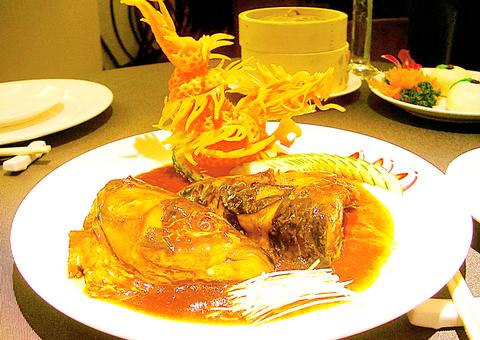If your idea of eating Shanghai-style is to sit in a crowded space amidst a cacophony of voices, with people constantly shouting "bottoms up!" then you're a bit behind the times. United Hotel's Modern Shanghai offers a chic and relaxed space for you to enjoy the traditional tastes of Shanghai without the noise and greasy floors.
United Hotel caters to the chic urban crowd and puts a premium on design, with cool, linear forms and spaces. In Modern Shanghai this is accomplished by black tables, French windows, spacious rooms and comfy chairs.
Modern Shanghai puts as much thought into its food as it does its design. The hotel's chef, Ku Lai-wen (

PHOTO: YU SEN-LUN, TAIPEI TIIMES
One dish that comes highly recommended is hairy crab, a must-try during the autumn season. It will be available for another month, so for those who have not yet tried these big and tasty crabs, Modern Shanghai may be a good choice.
Apart from steaming, the traditional method of preparing hairy crab, chef Ku has his own innovative way of stir-frying the crab in a spicy sauce, called hot and spicy hairy crab (
A special crab set menu, with eight dishes including different crab entrees and shark fin soup, is priced from NT$1,600 to NT$1,800, serving four people.
Smoked spare-ribs (
Deep fried yam balls (金毛獅王) is another of Ku's inventions. For this dish he uses mountain yams and fresh scallops to make a stuffing which is wrapped in a spring-roll skin, giving this dish a crispy outside and a soft inside. The restaurant also has a selection of traditional Shanghai soups, of which its old duck soup (
Most of the dishes at Modern Shanghai are served in portions for one person, adding a Western touch to the Chinese fare.

May 18 to May 24 Pastor Yang Hsu’s (楊煦) congregation was shocked upon seeing the land he chose to build his orphanage. It was surrounded by mountains on three sides, and the only way to access it was to cross a river by foot. The soil was poor due to runoff, and large rocks strewn across the plot prevented much from growing. In addition, there was no running water or electricity. But it was all Yang could afford. He and his Indigenous Atayal wife Lin Feng-ying (林鳳英) had already been caring for 24 orphans in their home, and they were in

On May 2, Chinese Nationalist Party (KMT) Chairman Eric Chu (朱立倫), at a meeting in support of Taipei city councilors at party headquarters, compared President William Lai (賴清德) to Hitler. Chu claimed that unlike any other democracy worldwide in history, no other leader was rooting out opposing parties like Lai and the Democratic Progressive Party (DPP). That his statements are wildly inaccurate was not the point. It was a rallying cry, not a history lesson. This was intentional to provoke the international diplomatic community into a response, which was promptly provided. Both the German and Israeli offices issued statements on Facebook

President William Lai (賴清德) yesterday delivered an address marking the first anniversary of his presidency. In the speech, Lai affirmed Taiwan’s global role in technology, trade and security. He announced economic and national security initiatives, and emphasized democratic values and cross-party cooperation. The following is the full text of his speech: Yesterday, outside of Beida Elementary School in New Taipei City’s Sanxia District (三峽), there was a major traffic accident that, sadly, claimed several lives and resulted in multiple injuries. The Executive Yuan immediately formed a task force, and last night I personally visited the victims in hospital. Central government agencies and the

Australia’s ABC last week published a piece on the recall campaign. The article emphasized the divisions in Taiwanese society and blamed the recall for worsening them. It quotes a supporter of the Taiwan People’s Party (TPP) as saying “I’m 43 years old, born and raised here, and I’ve never seen the country this divided in my entire life.” Apparently, as an adult, she slept through the post-election violence in 2000 and 2004 by the Chinese Nationalist Party (KMT), the veiled coup threats by the military when Chen Shui-bian (陳水扁) became president, the 2006 Red Shirt protests against him ginned up by